Story Highlights
- Satisfaction with income declines to 58% in 2015 from 66%
- Rural Chinese most likely to see their living standards getting worse
WASHINGTON, D.C. -- The satisfaction that Chinese have with their household income took a major hit in 2015, dropping from a high of 66% in 2014 to 58% in 2015 as tumbling stocks, a devaluing yuan and low consumer spending battered the Chinese economy.
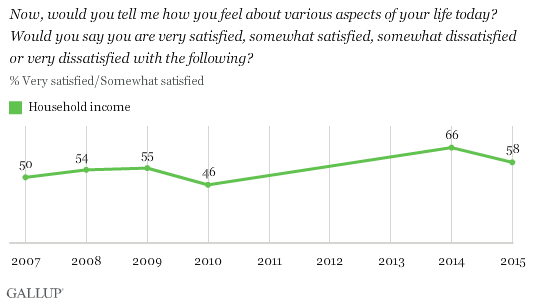
China's rebound after the global economic crisis was rather short-lived, revealing an underlying vulnerability. As China transitions from manufacturing to a modern service economy, many in the labor force continue to suffer from wage reduction or job loss, particularly unskilled workers who have not been trained in anything except factory work.
Not only are Chinese less satisfied with their 2015 household income, they are also less happy with the amount of money they have been able to save. Satisfaction with personal savings dipped to 39% from 44% in 2014, the highest level Gallup has recorded. Despite government efforts to encourage Chinese to spend, saving money for the future continues to be a fundamental priority for most. While it is true that satisfaction with savings has declined in the past year, at 39%, it is still higher than it was before the global financial crisis.
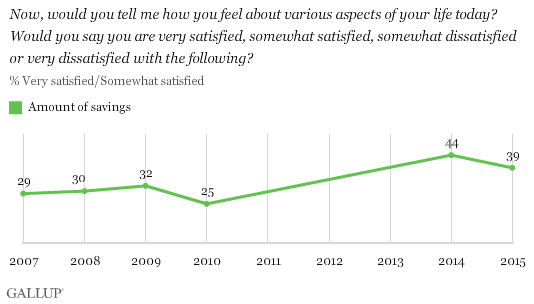
Satisfaction with savings has decreased among all age groups except the youngest Chinese, but the most substantial decline is among 35- to 49-year-olds -- those in their prime working and child-rearing years. Satisfaction with the amount of money this group has been able to save has dipped nine percentage points, from 47% in 2014 to 38% in 2015 -- which likely reflects, in part, the expense of raising and educating children in China.
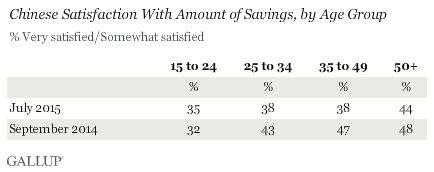
Fewer Chinese Believe Their Standard of Living Is Getting Better
With Chinese satisfaction over household income and savings sinking, it follows that optimism among Chinese about their standard of living would dip as well. Most Chinese, 76%, still say their living standards are getting better, but that sentiment has declined by five percentage points since 2014. And it is the lowest Gallup has measured since the global economic recession.
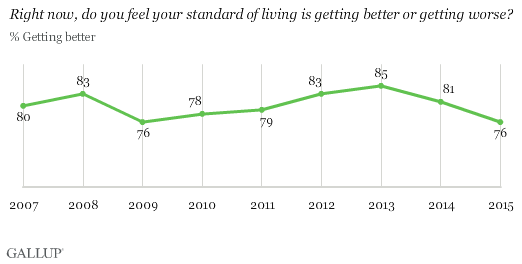
Declining optimism among rural Chinese is largely driving this change. In 2014, 80% of rural residents said their living standards were getting better, vs. 74% in 2015, while the decline among urban dwellers was two percentage points.
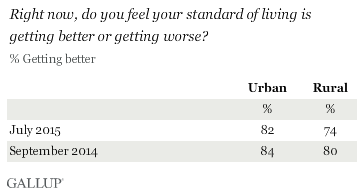
Further, when asked about their feelings toward their household income, 38% of rural Chinese say they find it "difficult" or "very difficult" to get by on their present income, compared with 24% of those living in cities. Overall, finding it "difficult" or "very difficult" to get by has increased since 2014 -- up eight points in rural areas and seven points in cities. The disparity between urban and rural attitudes probably reflects the reduced number of opportunities in agriculture and factories in rural China; those who have the skills and/or education to find work in the service sector head to the cities.
These data are available in Gallup Analytics.
Bottom Line
Given China's status as the world's second-largest economy, its slowdown has had a significant effect on financial markets worldwide -- a fresh market sell-off in China reverberated around the globe just last week. However, it is important to remember that the Chinese people are the first to be affected by their slowing economy. That their satisfaction with household income and savings has sunk precipitously since the all-time highs of 2014 suggests many Chinese consumers are feeling more vulnerable than they have in years. That shift may, in turn, further complicate government efforts to encourage greater spending among the world's largest consumer population.
Survey Methods
Results are based on interviews with 4,265 adults, aged 15 and older, including a national sample conducted face to face in China and an oversample conducted by landline telephone in Shanghai, Beijing and Guangzhou in July 2015. For results based on the total sample of national adults, the margin of sampling error is ±2 percentage points at the 95% confidence level. All reported margins of sampling error include computed design effects for weighting.
For more complete methodology and specific survey dates, please review Gallup's Country Data Set details.
Learn more about how the Gallup World Poll works.

